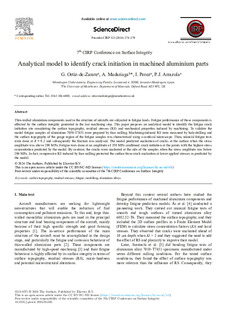Title
Analytical model to identify crack initiation in machined aluminium partsPublication Date
2024Other institutions
University of ManchesterVersion
Published versionDocument type
Conference ObjectConference ObjectLanguage
EnglishRights
© 2024 The Author(s)Access
Open accessPublisher’s version
https://doi.org/10.1016/j.procir.2024.05.049Published at
Procedia CIRP Vol. 123. Pp. 274-279, 2024Publisher
ElsevierKeywords
Surface topography
Residual stresses
Fatigue
modelling ... [+]
Residual stresses
Fatigue
modelling ... [+]
Surface topography
Residual stresses
Fatigue
modelling
aluminium alloys
ODS 9 Industria, innovación e infraestructura [-]
Residual stresses
Fatigue
modelling
aluminium alloys
ODS 9 Industria, innovación e infraestructura [-]
Abstract
Thin-walled aluminium components used in the structure of aircrafts are subjected to fatigue loads. Fatigue performance of those components is affected by the surface integrity generated in the last m ... [+]
Thin-walled aluminium components used in the structure of aircrafts are subjected to fatigue loads. Fatigue performance of those components is affected by the surface integrity generated in the last machining step. This paper proposes an analytical model to identify the fatigue crack initiation site considering the surface topography, residual stresses (RS) and mechanical properties induced by machining. To validate the model fatigue samples of aluminium 7050-T7451 were prepared by face milling. Machining-induced RS were measured by hole-drilling and the surface topography of the gauge region of the fatigue samples was characterised using a confocal microscope. Then, uniaxial fatigue tests were done at R = 0.1 and subsequently the fracture was analysed. The model predicted nucleation of cracks at the surface when the stress amplitude was above 290 MPa. Fatigue tests done at an amplitude of 350 MPa confirmed crack initiation at the points with the highest stress concentration predicted by the model. By contrast, the cracks were nucleated at the side of the samples when the stress amplitude was below 290 MPa. In fact, compressive RS induced by face milling protected the surface from crack nucleation at lower applied stresses as predicted by the model. [-]
Collections
The following license files are associated with this item:






















